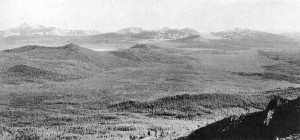The Geology of Crater Lake National Park, Oregon With a reconnaissance of the Cascade Range southward to Mount Shasta by Howell Williams
The Foundations of Mount Mazama
Other Pre-Mazama Lava Within the Park
The lavas occupying the northwest corner of the park and the slopes that lead thence to the Rogue River are composed principally of olivine-rich basaltic andesites similar to those of the Union Peak volcano. Some of these lavas are related to Red Cone, Desert Cone, and Bald Crater, but most of them are much older. Although they are not exposed on the walls of Crater Lake, there is little doubt that they form the foundation beneath Mount Mazama and are of approximately the same age as the lavas of Union Peak. In other words, they belong to the older volcanic series of the High Cascades and antedate the great composite cones. Probably they were erupted in Pliocene and early Pleistocene times.
Generally there is little difficulty in distinguishing these lavas from those of Mount Mazama, for they are usually rich in granules of olivine and devoid of the large feldspar crystals that characterize the Mazama flows. Most of them are so fine-grained that only grains of olivine and pyroxene and specks of feldspar can be recognized by the unaided eye. In color they range from pale gray to black, and, as on Union Peak, the darker flows are usually more vesicular. Some types are holocrystalline and have an ophitic texture; others include much glass and are darker.
Diller referred to these lavas as the Desert Cone and Red Cone basalts on the assumption that they were erupted from those vents, but although similar flows do occur on these cones and in their immediate vicinity, most of the lavas in the northwest corner of the park are much older. This is not to deny that some of them may have been erupted from older vents beneath those cones; indeed, the attitudes of the flow planes point to sources thereabouts. Possibly the youthful Red and Desert cones were the result of renewed activity at vents which had lain dormant throughout the growth of Mount Mazama. (See plate 4, figure 2.)
|
Plate 4. Fig. 2. Looking south from Mount Bailey to the rim of Crater Lake. The wooded hill in the left middle distance is Desert Ridge, composed of pre-Mazama lavas. To the south (right) rise Desert and Red cones, two parasitic scoria cones on the flank of Mount Mazama. Beyond Red Cone, leading up to the caldera rim, is a bare slope of pumice. Almost all the low, wooded country is blanketed with deposits of pumice and scoria flows from Mount Mazama. (Photograph by Victor Duran.) |
Not all the pre-Mazama lavas of this region issued from vents near the parasitic cones just mentioned; many are related to the ruined volcano of Desert Ridge. The thick glaciers that once swept down the north side of Mount Mazama almost completely buried this volcano, subjecting it to severe erosion. There is now no trace of a summit crater. Nevertheless, the vague flow banding of the lavas suggests a vent on the north boundary of the park, near post 51. Apparently the volcano was built entirely of lava. Precisely similar flows form the younger volcanoes of Twin Knobs and Sherwood Buttes, respectively 4 and 6 miles to die northwest.


